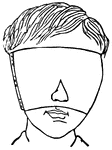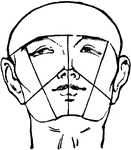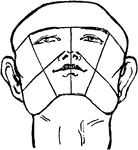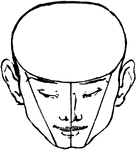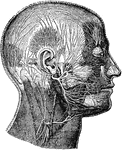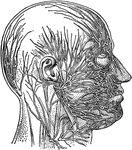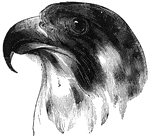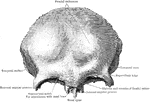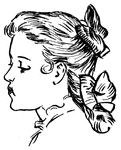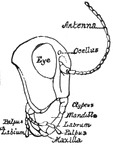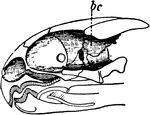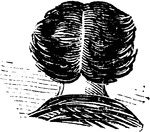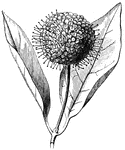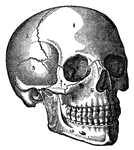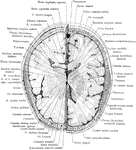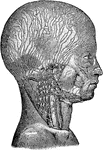
Perpendicular Plate of Ethmoid
Perpendicular plate of ethmoid, shown by removing the right lateral mass.
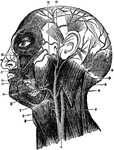
Arteries of the Face and Head
The arteries of the face and head. Labels: 1, common carotid; 2, internal carotid; 3, external carotid;…
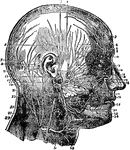
Nerves of the Face and Scalp
Nerves of the face and scalp. Labels: 1, attrahensaurem; 2, anterior belly occipito-frontalis; 3, auriculo-temporal…
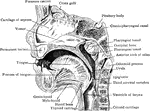
Mesial Sagittal Section of Child's Face
Anterior portion of mesial sagittal section of child's head, probably of about three year.

Facial Bandage
This illustration shows a method of applying a bandage to the face to cover both eyes.

Remora Fish
A genus of fished included in the Goby family, and of which the common remora or sucking fish, is the…

Fowl Skull
The skull of an adult fowl. Here the temporal fossa is bridged over by the junction of the post-frontal…

Frontal Bone of the Human Skull
Frontal bone of the human skull, outer surface. The frontal bone forms the forehead, roof of the orbital…

Gilt-Head
"Twelve inches long, abundant in the Mediterranean, and found on the coasts of Africa and Europe, from…

Gilt-Head
"Six to eight inches long, its general color being red varied with green." — Goodrich, 1859
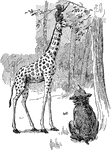
Giraffe Eating Leaves with a Monkey Sitting on Leaves
An illustration of a giraffe eating leaves with a monkey sitting on the giraffe's head.
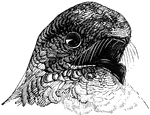
Head of a Goat-Sucker
Head of the goat-sucker. It bears some resemblence to an owl, with a large head and eyes, as well as…

Head of a Great Jacamar
The head of a Great Jacamar, a bird belonging to the Scansores order. Scansores is an order of birds,…

Guillotine
The guillotine was a device used for carrying out executions by decapitation. It consists of a tall…

Black-headed Gull
"A long-winged water-bird with webbed feet, inhabiting all parts of the world. The group to which gulls…

Great Black Backed Gull
"A long-winged water-bird with webbed feet, inhabiting all parts of the world. The group to which gulls…

Herring Gull
"A long-winged water-bird with webbed feet, inhabiting all parts of the world. The group to which gulls…
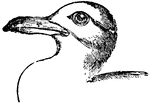
Killiwake Gull
"A long-winged water-bird with webbed feet, inhabiting all parts of the world. The group to which gulls…
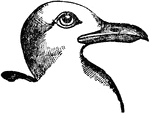
Small Black-Backed Gull
"A long-winged water-bird with webbed feet, inhabiting all parts of the world. The group to which gulls…
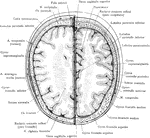
Cross Section of Head 3 cm above Supraorbital Border
Section of head 3 cm above supraorbital border.
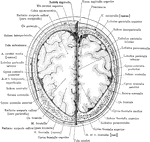
Cross Section of Head 4 cm above Supraorbital Border
Section of head 4 cm above supraorbital border.
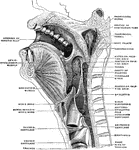
Sagittal Section of the Head and Neck
Sagittal median section of the head and neck. The head is thrown backward into complete extension which…
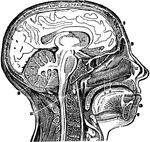
Head and Neck, Section of
Vertical middle section of head and neck showing the opening through the Eustachian tube, and its relations…

Section of the Head and Neck
Section of head and neck from front to back. Labels: 1, windpipe; 2, larynx; 3, spinal marrow; 4, pharynx;…

Section of the Head and Neck
Sagittal section through mouth, tongue, larynx, pharynx, and nasal cavity. The section was slightly…
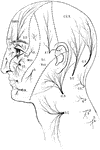
Sensory Nerves to the Head and Neck
Distribution of sensory nerves to the head and neck. Labels: Ophth, ophthalmic division of the fifth…
